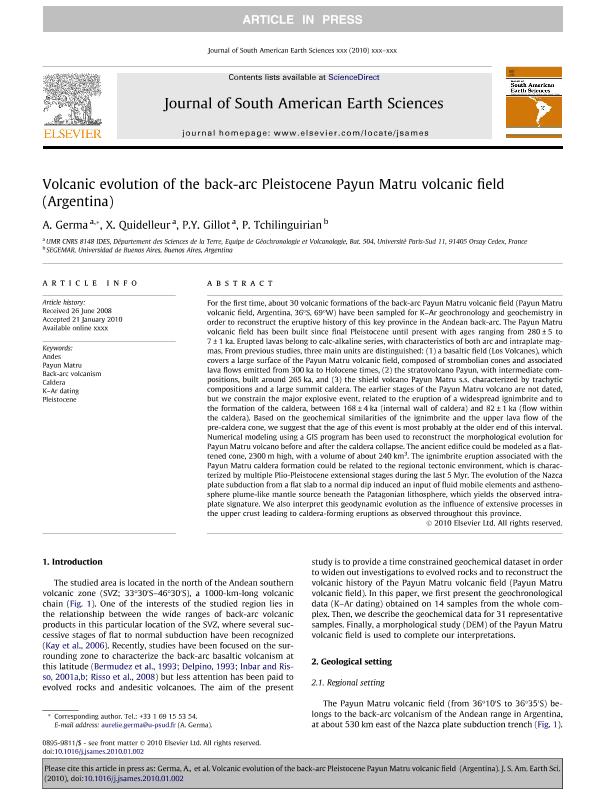Mostrar el registro sencillo del ítem
dc.contributor.author
Germa, A.
dc.contributor.author
Quidelleur, X.
dc.contributor.author
Gillot, P.Y.
dc.contributor.author
Tchilinguirian, Pablo

dc.date.available
2020-03-06T14:16:06Z
dc.date.issued
2010-04
dc.identifier.citation
Germa, A.; Quidelleur, X.; Gillot, P.Y.; Tchilinguirian, Pablo; Volcanic evolution of the back-arc Pleistocene Payun Matru volcanic field (Argentina); Pergamon-Elsevier Science Ltd; Journal of South American Earth Sciences; 29; 3; 4-2010; 717-730
dc.identifier.issn
0895-9811
dc.identifier.uri
http://hdl.handle.net/11336/98912
dc.description.abstract
For the first time, about 30 volcanic formations of the back-arc Payun Matru volcanic field (Payun Matru volcanic field, Argentina, 36°S, 69°W) have been sampled for K-Ar geochronology and geochemistry in order to reconstruct the eruptive history of this key province in the Andean back-arc. The Payun Matru volcanic field has been built since final Pleistocene until present with ages ranging from 280±5 to 7±1ka. Erupted lavas belong to calc-alkaline series, with characteristics of both arc and intraplate magmas. From previous studies, three main units are distinguished: (1) a basaltic field (Los Volcanes), which covers a large surface of the Payun Matru volcanic field, composed of strombolian cones and associated lava flows emitted from 300ka to Holocene times, (2) the stratovolcano Payun, with intermediate compositions, built around 265ka, and (3) the shield volcano Payun Matru s.s. characterized by trachytic compositions and a large summit caldera. The earlier stages of the Payun Matru volcano are not dated, but we constrain the major explosive event, related to the eruption of a widespread ignimbrite and to the formation of the caldera, between 168±4ka (internal wall of caldera) and 82±1ka (flow within the caldera). Based on the geochemical similarities of the ignimbrite and the upper lava flow of the pre-caldera cone, we suggest that the age of this event is most probably at the older end of this interval. Numerical modeling using a GIS program has been used to reconstruct the morphological evolution for Payun Matru volcano before and after the caldera collapse. The ancient edifice could be modeled as a flattened cone, 2300m high, with a volume of about 240km3. The ignimbrite eruption associated with the Payun Matru caldera formation could be related to the regional tectonic environment, which is characterized by multiple Plio-Pleistocene extensional stages during the last 5Myr. The evolution of the Nazca plate subduction from a flat slab to a normal dip induced an input of fluid mobile elements and asthenosphere plume-like mantle source beneath the Patagonian lithosphere, which yields the observed intraplate signature. We also interpret this geodynamic evolution as the influence of extensive processes in the upper crust leading to caldera-forming eruptions as observed throughout this province.
dc.format
application/pdf
dc.language.iso
eng
dc.publisher
Pergamon-Elsevier Science Ltd

dc.rights
info:eu-repo/semantics/openAccess
dc.rights.uri
https://creativecommons.org/licenses/by-nc-sa/2.5/ar/
dc.subject
ANDES
dc.subject
BACK-ARC VOLCANISM
dc.subject
CALDERA
dc.subject
K-AR DATING
dc.subject
PAYUN MATRU
dc.subject
PLEISTOCENE
dc.subject.classification
Vulcanología

dc.subject.classification
Ciencias de la Tierra y relacionadas con el Medio Ambiente

dc.subject.classification
CIENCIAS NATURALES Y EXACTAS

dc.title
Volcanic evolution of the back-arc Pleistocene Payun Matru volcanic field (Argentina)
dc.type
info:eu-repo/semantics/article
dc.type
info:ar-repo/semantics/artículo
dc.type
info:eu-repo/semantics/publishedVersion
dc.date.updated
2020-03-04T17:34:13Z
dc.journal.volume
29
dc.journal.number
3
dc.journal.pagination
717-730
dc.journal.pais
Países Bajos

dc.journal.ciudad
Amsterdam
dc.description.fil
Fil: Germa, A.. Université Paris Sud; Francia. Centre National de la Recherche Scientifique; Francia
dc.description.fil
Fil: Quidelleur, X.. Université Paris Sud; Francia. Centre National de la Recherche Scientifique; Francia
dc.description.fil
Fil: Gillot, P.Y.. Université Paris Sud; Francia. Centre National de la Recherche Scientifique; Francia
dc.description.fil
Fil: Tchilinguirian, Pablo. Universidad de Buenos Aires; Argentina. Secretaría de Industria y Minería. Servicio Geológico Minero Argentino; Argentina. Consejo Nacional de Investigaciones Científicas y Técnicas; Argentina
dc.journal.title
Journal of South American Earth Sciences

dc.relation.alternativeid
info:eu-repo/semantics/altIdentifier/url/https://www.sciencedirect.com/science/article/pii/S0895981110000040
dc.relation.alternativeid
info:eu-repo/semantics/altIdentifier/doi/http://dx.doi.org/10.1016/j.jsames.2010.01.002
Archivos asociados
